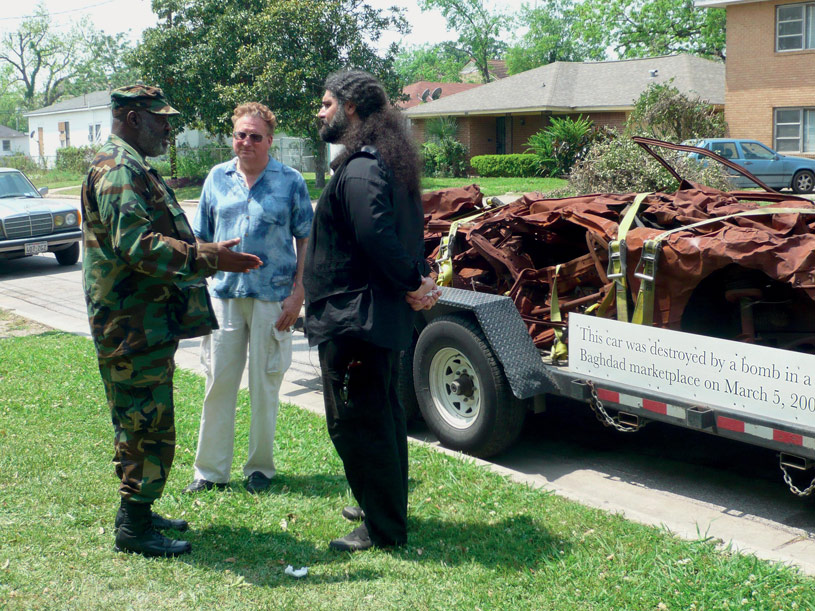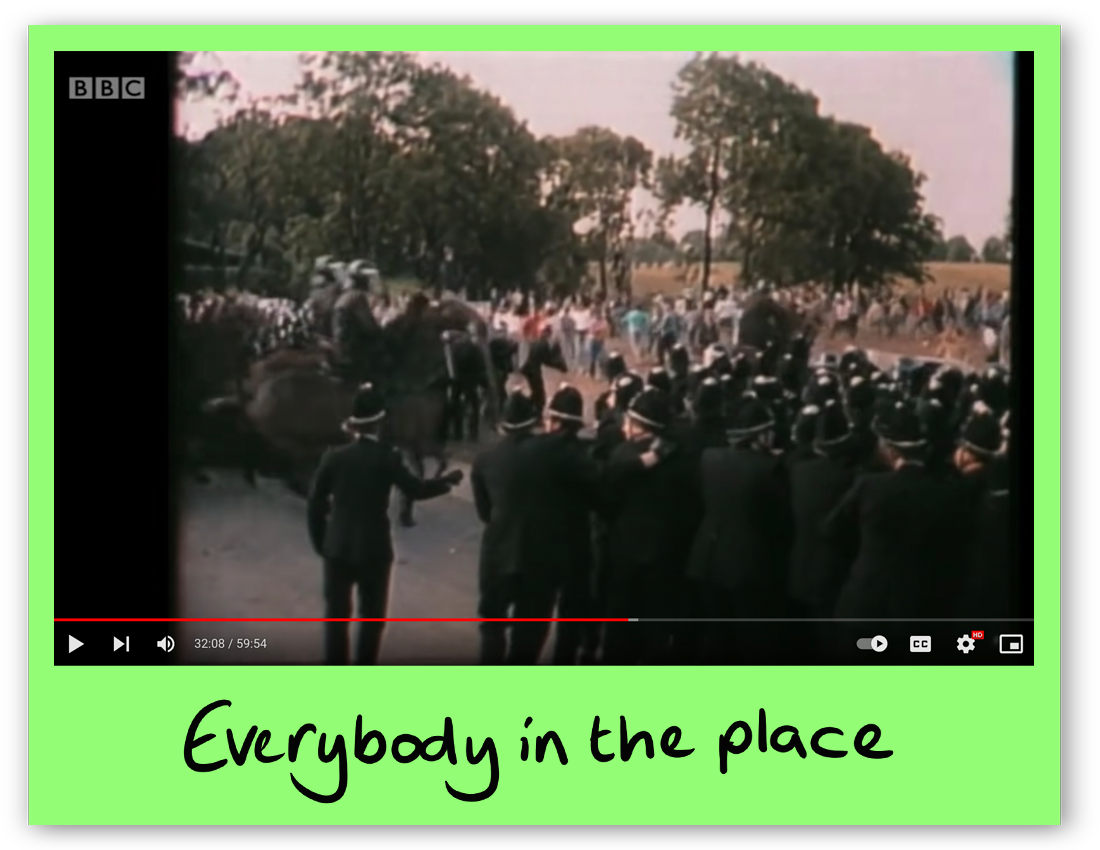
Jeremy Deller’s talk
This talk was recorded as part of a live online workshop with Jeremy Deller, young participants, Courtauld educator Francesca Herrick and illustrator Toya Walker. In the talk Jeremy discusses his work, from The Battle of Orgreave (2001) to Putin’s Happy (2019) and what he finds interesting about The Impressionist collection at The Courtauld. In the second half of the film (from 35:15 onwards) Jeremy answers questions from the young people who took part in the online session.

It is what it is

It is what is is: Conversations about Iraq (2009)
In 2008 Jeremy was shortlisted for the 4th Plinth, Trafalgar Square. His idea was to get a car that had been destroyed in a bomb attack in Iraq and leave it to rust on the plinth.
This was the height of the Iraq War (2003-2011) and the car would provide a piece of evidence so that people in the UK could see the direct effects of conflict. Jeremy’s highly political proposal was not selected for the 4th Plinth, but he was keen to develop the concept. He ended up taking the car across America with an Iraqi citizen.
Text on the car read: “destroyed by the bombing of Baghdad marketplace on March 5th 2007.” It was not anti-war nor pro war, just a factual statement of what had happened to that car. A major part of the project was engaging with people on the streets who were surprised to see the car.
Discuss: The Baghdad car (It Is What It Is, 2009) is a modern day equivalent of a ‘history painting’. In Manet’s lifetime this referred to artists painting modern political subjects, such as battle scenes. Manet arguably created a new approach by applying a similar large-scale, heroic format to normal people in modern settings.
Deller has said there is no subject that is off limits to an artist, similar to a journalist. Do you agree with this view? Do you think Manet had the same outlook?
Both Manet and Deller have placed strikingly contemporary and political subject matter in potentially hostile contexts. Do you think that artists have a responsibility to engage with current issues and spark debate?
What subjects or stories would you want to capture from current times? See how A-level art student Kanar has developed a personal response to Manet’s Bar and Deller’s Baghdad Car.

About Jeremy Deller
Jeremy Deller is one of Britain’s most celebrated artists, best known for his works We’re Here Because We’re Here and The Battle of Orgreave.
Mostly collaborative, his work spans music, documentaries, posters, installations and historical re-enactments. From convincing a brass band to cover techno music for his Acid Brass project, to touring a bombed car from the Iraq War around the US, his work encompasses politics, history and social anthropology.
His recent projects include Everybody in the Place, a BBC4 documentary exploring rave culture, and Putin’s Happy, a short film following pro- and anti-Brexit protestors in Parliament Square 2019. Deller studied art history at The Courtauld. He won the Turner Prize in 2004 and represented Britain at the Venice Biennale in 2013.

EVERYBODY IN THE PLACE
Everybody in the place: An incomplete history of Britain, 1984-92 (2018)
The film takes place in a classroom in London, with Jeremy telling a group of A-level politics students the story of Acid House and rave culture in Britain in the 1980s and 90s. His approach is very interactive, inviting students to try out music equipment from the 1980s, including synthesizers and drum machines.
A significant part of the film involves the students responding to historical footage. A history of music becomes also a history of social, economic and political events of the late 20th century. This was the first time many of the participants had heard about the Miners’ Strike (1984-85). The main emphasis is on the young people’s reactions today rather than interviewing people from the original music scene.
Discuss: Jeremy’s film offers an alternative approach and model for historical research. Manet’s A Bar at the Folies-Bergère (1882) can also be related to different experiences around music and performance.
Consider how both Manet’s painting and Deller’s film offer different lenses for looking at history. Whose perspectives are represented in each case?
Both artworks deal with individual and collective encounters within a particular scene. What under-represented histories would be enhanced by looking at more everyday experiences?
Think of a genre of music/performance that you are interested in. How would you present its history? Perhaps this is very recent. What events could you connect to?
Jeremy Deller is one of Britain’s most celebrated artists, best known for his works We’re Here Because We’re Here and The Battle of Orgreave.
Mostly collaborative, his work spans music, documentaries, posters, installations and historical re-enactments. From convincing a brass band to cover techno music for his Acid Brass project, to touring a bombed car from the Iraq War around the US, his work encompasses politics, history and social anthropology.
His recent projects include Everybody in the Place, a BBC4 documentary exploring rave culture, and Putin’s Happy, a short film following pro- and anti-Brexit protestors in Parliament Square 2019. Deller studied art history at The Courtauld. He won the Turner Prize in 2004 and represented Britain at the Venice Biennale in 2013.
Watch Jeremy Deller’s talk for young people here.
This talk was recorded as part of a live online workshop with Jeremy Deller, young participants, Courtauld educator Francesca Herrick and illustrator Toya Walker. In the talk Jeremy discusses his work, from The Battle of Orgreave (2001) to Putin’s Happy (2019) and what he finds interesting about The Impressionist collection at The Courtauld. In the second half of the film (from 35:15 onwards) Jeremy answers questions from the young people who took part in the online session.
It is what is is: Conversations about Iraq (2009)
In 2008 Jeremy was shortlisted for the 4th Plinth, Trafalgar Square. His idea was to get a car that had been destroyed in a bomb attack in Iraq and leave it to rust on the plinth.
This was the height of the Iraq War (2003-2011) and the car would provide a piece of evidence so that people in the UK could see the direct effects of conflict. Jeremy’s highly political proposal was not selected for the 4th Plinth, but he was keen to develop the concept. He ended up taking the car across America with an Iraqi citizen.
Text on the car read: “destroyed by the bombing of Baghdad marketplace on March 5th 2007.” It was not anti-war nor pro war, just a factual statement of what had happened to that car. A major part of the project was engaging with people on the streets who were surprised to see the car.
Discuss: The Baghdad car (It Is What It Is, 2009) is a modern day equivalent of a ‘history painting’. In Manet’s lifetime this referred to artists painting modern political subjects, such as battle scenes. Manet arguably created a new approach by applying a similar large-scale, heroic format to normal people in modern settings.
Deller has said there is no subject that is off limits to an artist, similar to a journalist. Do you agree with this view? Do you think Manet had the same outlook?
Both Manet and Deller have placed strikingly contemporary and political subject matter in potentially hostile contexts. Do you think that artists have a responsibility to engage with current issues and spark debate?
What subjects or stories would you want to capture from current times? See how A-level art student Kanar has developed a personal response to Manet’s Bar and Deller’s Baghdad Car.
Everybody in the place: An incomplete history of Britain, 1984-92 (2018)
The film takes place in a classroom in London, with Jeremy telling a group of A-level politics students the story of Acid House and rave culture in Britain in the 1980s and 90s. His approach is very interactive, inviting students to try out music equipment from the 1980s, including synthesizers and drum machines.
A significant part of the film involves the students responding to historical footage. A history of music becomes also a history of social, economic and political events of the late 20th century. This was the first time many of the participants had heard about the Miners’ Strike (1984-85). The main emphasis is on the young people’s reactions today rather than interviewing people from the original music scene.
Discuss: Jeremy’s film offers an alternative approach and model for historical research. Manet’s A Bar at the Folies-Bergère (1882) can also be related to different experiences around music and performance.
Consider how both Manet’s paintingand Deller’s film offer different lenses for looking at history. Whose perspectives are represented in each case?
Both artworks deal with individual and collective encounters within a particular scene. What under-represented histories would be enhanced by looking at more everyday experiences?
Think of a genre of music/performance that you are interested in. How would you present its history? Perhaps this is very recent. What events could you connect to?

